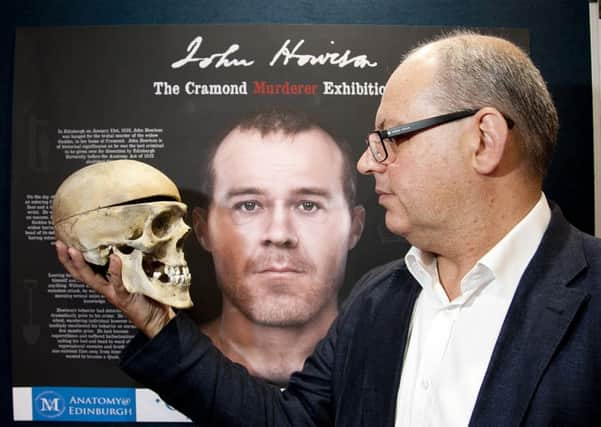Face to face with the Cramond killer


Now a 19th century Edinburgh murderer who killed a widow with a garden spade has been unmasked – nearly two centuries after his public execution.
The true story behind the little-known case has been compiled for a new exhibition in Cramond, Edinburgh, where the gruesome episode unfolded in 1831. It is expected to shed light on John Howison, the “Cramond Killer,” whose courtroom plea of insanity helped change the law for sufferers of paranoid schizophrenia.
Advertisement
Hide AdThe collaboration between the city council and Edinburgh University, suggests Howison should have been spared the gallows and treated for mental illness, despite confessing to seven other murders before he was hanged.
His body was the last to be sent to the university’s medical school by the courts before the tradition was ended by the 1832 Anatomy Act. The latest forensic techniques have been carried out on his remains, which are on permanent display in the university’s Anatomical Museum, to create an image of how he would have looked.
Archeological findings in Cramond, local historical records and pathology reports from the time have all been deployed to create the new display for the Maltings museum in Cramond.
Howison, who entered Cramond with a black handkerchief over his face and a Bible dangling from his wrist, entered the house of a stranger and sliced her head in two. He fled without taking anything, but was apprehended the next day.
The exhibition recalls how Howison’s landlady in the Canongate had noticed a “dramatic deterioration” in his behaviour in the months leading up to the murder, including suffering hallucinations, brushing nonexistent flies off his hands and sprinkling salt on his bed to ward off “supernatural enemies”.
The university says Howison’s symptoms now look like “almost a textbook case” for schizophrenia, then unrecognised as an illness. Janet Philp, head of administration in the deanery of biomedical sciences, said: “The Anatomy Act was basically introduced to end the business of body-snatching, but it also stopped the practice of criminals being sentenced to execution and dissection.”
Advertisement
Hide AdJohn Lawson, the council’s archeologist, said: “I don’t think the story of John Howison is that well known. I’d actually never heard of him until we started work on the project. However in certain circles it’s a celebrated case because he was the last person to be executed before the Anatomy Act and the evidence at his trial that pleaded insanity on his behalf. It’s great to bring it back into the public eye.”